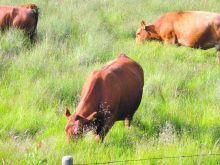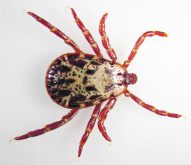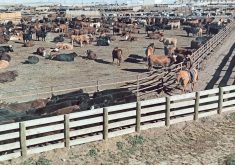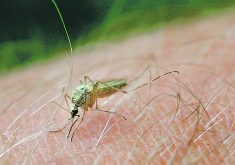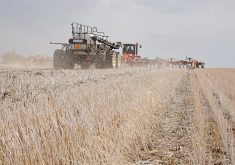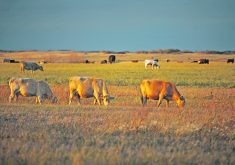Enteric methane will be the federal government’s next big target that agricultural producers are expected to aim for.
It’s the methane cattle produce when they digest food and is released mainly through respiration.
Agriculture Canada made two big announcements recently that brought methane to the forefront of its climate change policy.
In December, at the COP28 meetings in Dubai, the department released a draft protocol for creating offset credits intended to incentivize beef farmers to reduce methane.
And a month earlier, it announced a $12 million Agricultural Methane Reduction Challenge that awards funding to innovators who can come up with low-cost and scalable methods and technologies that reduce enteric methane emissions.
“There’s going to be increasing pressure on the industry to meet those goals or to respond to those goals,” said Karen Beauchemin, a recently retired research scientist from Agriculture Canada’s Lethbridge Research and Development Centre, while speaking at the Manitoba Beef and Forage Production Conference in Brandon late last year.
The looming targets are inevitable, considering Canada has made lofty international commitments to reduce methane.
Two years ago, at COP26 in Glasgow, Canada committed to reducing greenhouse gases by 40 percent below 2005 levels, as well as reducing methane emissions by 30 percent — all by 2030.
“That’s a huge goal, and we’re nowhere near close to meeting those targets,” said Beauchemin, who also pointed out that methane targets are not just coming from the government. They’re also coming from the private sector.
“Companies like Tyson Foods and Cargill are setting goals of reducing their greenhouse gas emissions by 30 percent or 50 percent or becoming net zero by 2050,” said Beauchemin. “The goals are going to be more and more challenging to ignore. It’s not going away.”
Fortunately, there’s some hope.
An Agriculture Canada study from Lethbridge looked at the emissions associated with producing beef in 1981 compared to 30 years later in 2011.
“What we saw was that over that 30-year period, there was a reduction in the amount of greenhouse gas emissions per kilogram of beef of about 15 percent,” said Beauchemin.
“That was simply by adopting better nutrition, better genetics, better farm management and better animal management.”
So even just following the status quo reduces greenhouse gases. Assuming those reductions apply to methane, that’s the good news. The bad news is that 15 percent over 30 years isn’t going to cut it when the target is to reduce methane by 30 percent in six years.
“The status quo is good, but it’s not going to get us where the industry needs to be to be competitive with industries around the world that are also setting very ambitious targets,” said Beauchemin.
Reaching those targets can be done in three ways.
“The first is increasing production efficiency. The second is reducing the amount of methane formed in the animal’s rumen when it digests feed, and the third, unfortunately, is reducing the demand for products,” she said.
“I say ‘unfortunately’ because that’s often what the media focuses on. That’s often what consumers are bombarded with: meatless Mondays, vegan diets, vegetarian hamburgers, etc. So I’m going to focus on the first two.”
Production efficiency
The example from the 30-year Agriculture Canada study in Lethbridge study shows that without even trying, the industry can reduce emissions by improving production efficiency. However, more can be done in that area.
Another study led by researcher Gabriel Ribeiro at the Lethbridge Research and Development Centre feedlot looked at the effects of using growth implants on various sustainability metrics. That research found a three- to 10-percent reduction in greenhouse gas emissions per kilogram of boneless beef.
“If you’re decreasing the number of days on feed, you can improve all of your sustainability metrics,” said Kim Ominski, a University of Manitoba animal science professor who was a co-author of the implant study, “because you have animals that are on the ground for a shorter period of time producing that methane.”
A little less than 30 percent of cow-calf operations are currently using growth hormone implants, leaving room for the technology to lower methane emissions.
Reducing methane production
“Is there a way of feeding cows that reduces the amount of methane in the rumen? That’s been the focus of a lot of research in recent years,” said Beauchemin.
“And the answer is ‘yes, but.’ ”
She pointed out that the diet of the animal is one of the biggest determinants of how much methane it will produce.
“Put simply, if you’re feeding a feedlot finishing diet, they’re going to produce way less methane than an animal that’s fed a forage-based diet,” she said.
“When you feed a cow forage, about eight percent of all the energy that animal is consuming is lost in the form of methane energy, right off the top.”
However, Beauchemin said it is possible to maintain a forage-based system and also produce less methane.
“The number one thing is digestibility. So if you have forage that’s more highly digestible, that means it has a higher energy content, and there’s less methane being produced because animals are growing faster. If you’re feeding straw, it’s going to produce a lot more methane than if you’re feeding, say, alfalfa. If you add legumes to your pasture mix, you reduce methane emissions. Grasses result in more methane than legumes.”
Genetics also play an important role.
“(Methane production) is a heritable characteristic,” Beauchemin said.
“So if you have a similar population of animals and you feed them the same diet, what you’ll see is that there’s about a 30 percent difference between the animals that are high emitters and the animals that are low emitters.”
This variability is providing opportunities for geneticists.
In New Zealand, for example, they now have a low-methane line of sheep that produce, on average, about 10 percent less methane.
“The problem is that to do that, you need to measure methane in a large number of animals. And that’s the challenge for beef cattle,” said Beauchemin.
“For dairy, it’s a lot easier because you have animals going up to an automatic feeder or milking parlour where you can get measurements.”
Fat supplements can also reduce methane production in the rumen.
“For every one percent fat you enter the diet, you reduce methane by about three to five percent,” said Beauchemin.
The challenge, however, is that many of those fat sources are quite expensive.
“You have to look for opportunities like frozen oilseeds, off-green oilseeds or restaurant grease. You also have to be careful because, in a forage diet, there’s only so much fat; you need to limit that fat to about three percent maximum.”
While there is some potential, Beauchemin said it’s probably more effective in a feedlot where cattle are getting a higher-grain diet.

Feed additives
Beauchemin said feed additives are another area of interest for methane reduction, and one getting a lot of attention is three nitro-oxypropanol (3-NOP), a feed additive manufactured by the European company DSM Nutrition.
The product blocks the biochemical synthesis of methane in the rumen.
“When you add it to the diet, you can reduce methane emissions in a high-grain diet from 40 to 80 percent,” said Beauchemin.
“In a forage diet, that reduction is lower — maybe 20 to 40 percent reduction in methane, with no negative effects on animal production.”
While the additive is not currently commercially available in Canada, after a review of 3-NOP regulations, the Canadian Food Inspection Agency recommended the additive’s approval in December 2023.
“We’ve talked a lot about this product for years, and finally, I think it’s going to be available to producers next year,” said Beauchemin. “The caveat is the way it’s going to be registered is for use in a total mixed ration.”
That means for now, anyway, it’s probably only going to be applicable in limited circumstances, such as in feedlots and dairies, where animals are fed a very controlled diet.
Another promising avenue for methane reduction, and one that is seeing a lot of private-sector investment, is with a seaweed called Asparagopsis taxiformi.
“It’s a red tropical seaweed that is not grown on the Atlantic or Pacific Ocean coasts of Canada, so the way that it would be produced locally would be in an artificial tank,” said Beauchemin.
The seaweed hasn’t been studied extensively, but in the studies that have been done, Beauchemin said they are seeing methane reductions of more than 90 percent in grain-based diets.
The active ingredient in the seaweed is called bromaform. Some companies are working on chemically synthesizing the active ingredient to eliminate the need for harvesting the seaweed. Others are looking at breeding transgenic plants that produce bromaform.
However, one of the problems with bromaform is that it’s highly volatile. After three months, instead of getting a 90 percent reduction in methane production, it drops closer to 30 percent.
“That’s because a lot of that bromoform has gone into the atmosphere,” said Beauchemin.
“So companies are trying to figure out how to stabilize that.”
But even more concerning is that in the United States, bromoform is classified as a probable human carcinogen.
While Beauchemin said the research to date has shown no residual levels of bromoform present in the milk or meat of animals fed the additive, more work needs to be done.
“The last thing we want to do is put a human carcinogen into our high-quality meat and milk.”
Return on investment
Beauchemin pointed out that the problem with all of this is that methane reduction does not always translate into an improvement in animal performance.
The draft methane offset protocol released by Agriculture Canada provides a glimmer of hope, but it’s a difficult document to digest. Parsing through the formulas and methodologies to understand what is expected of the farmer is no easy task.
However, Beauchemin did some back-of-the-napkin math to demonstrate what it might look like.
“Right now, the price of carbon dioxide is $65 a tonne on the offset market. Animals are currently producing about 3.8 kilograms per day of CO2 equivalent. If your treated animals are producing 50 percent less methane, the difference, at $65 a tonne, is about 12 cents per head per day, So if you can buy feed additives that reduce methane for less than 12 cents per head per day, and you can sell those through that offset market, you’re going to have another revenue stream.
“But the problem is that most of the inhibitors that I’ve seen that reduce methane by 50 percent are not anywhere close to 12 cents per head per day right now.”
Looking ahead
However, there are a lot of technologies in the pipeline. One of the most exciting is a methane-reducing vaccine.
“Low-methane vaccines are a technically challenging problem, but I think we’re going to see them within 10 years,” said Beauchemin. However, if it’s 10 years out, it won’t help meet a target only six years away.
Beachemin said it’s important to make sure the other side of cattle grazing becomes part of the conversation.
“The big thing for beef cow-calf operators is the carbon in soils,” she said, adding that it’s important to consider methane as it relates to sequestering carbon in soils.
“We need to change the dialogue. We have a huge story that we can be promoting and telling. So it’s not just about methane emitted from our cows. It’s also about the benefits to the ecosystem that those cow herds are having.”





